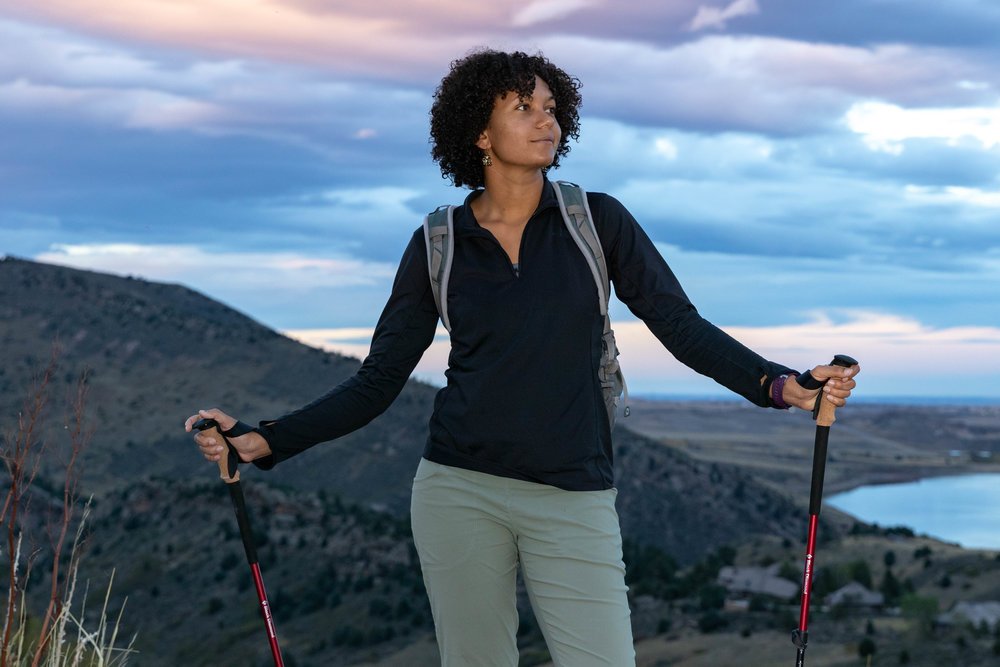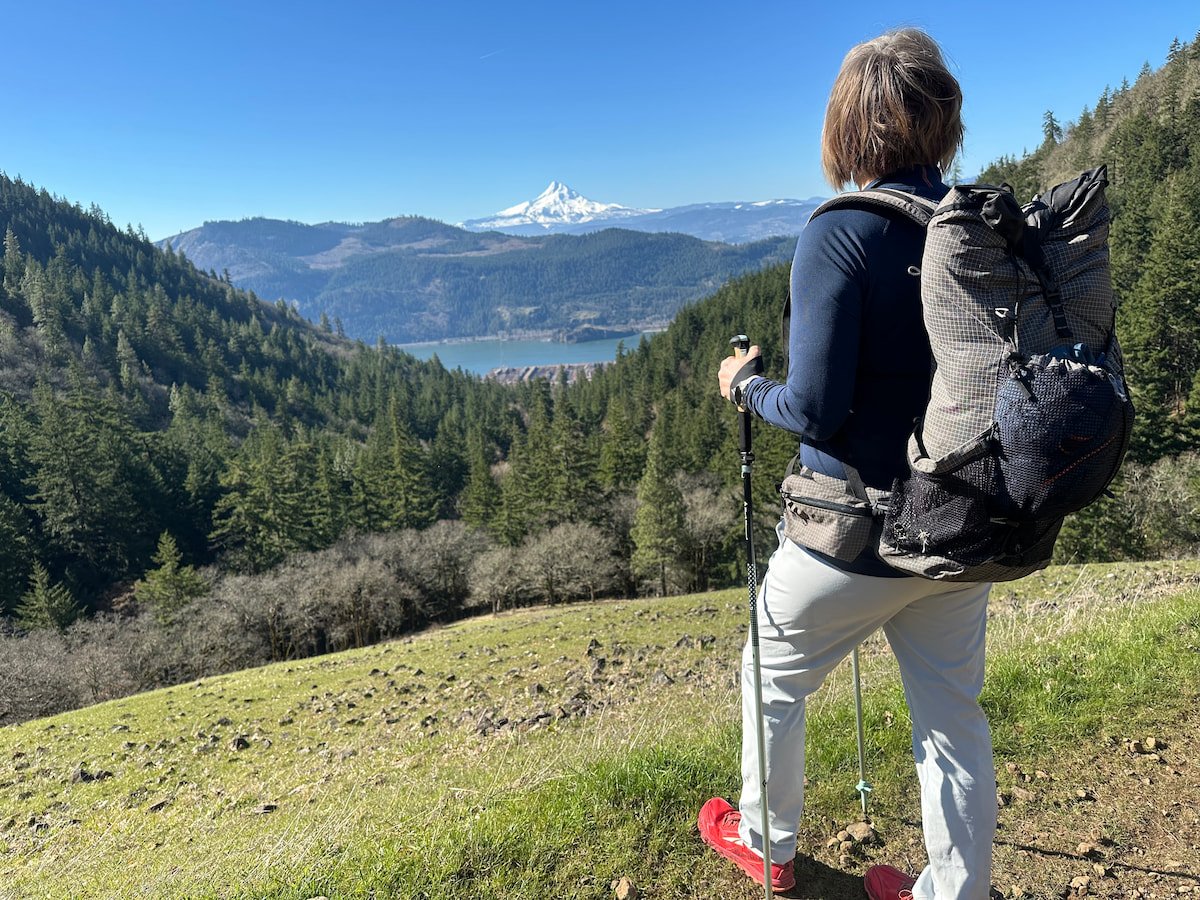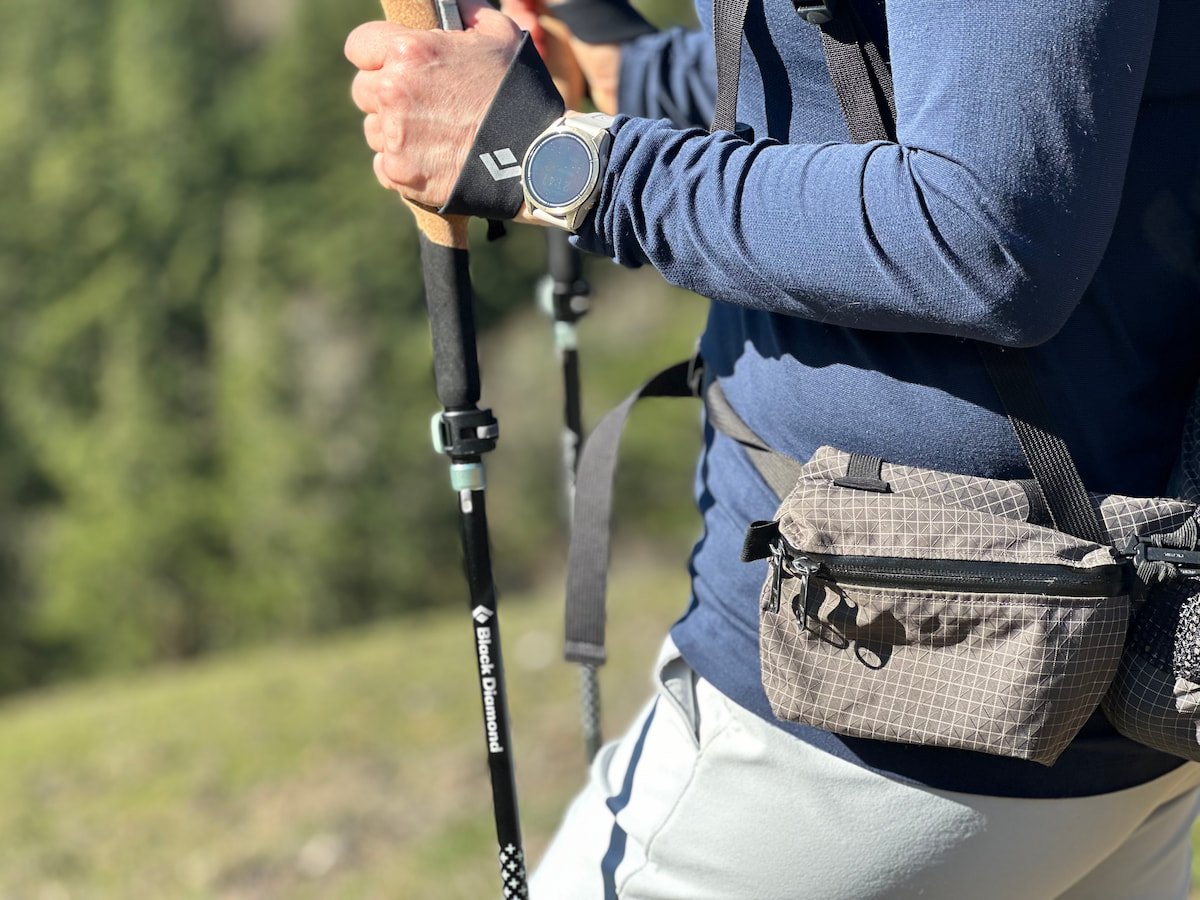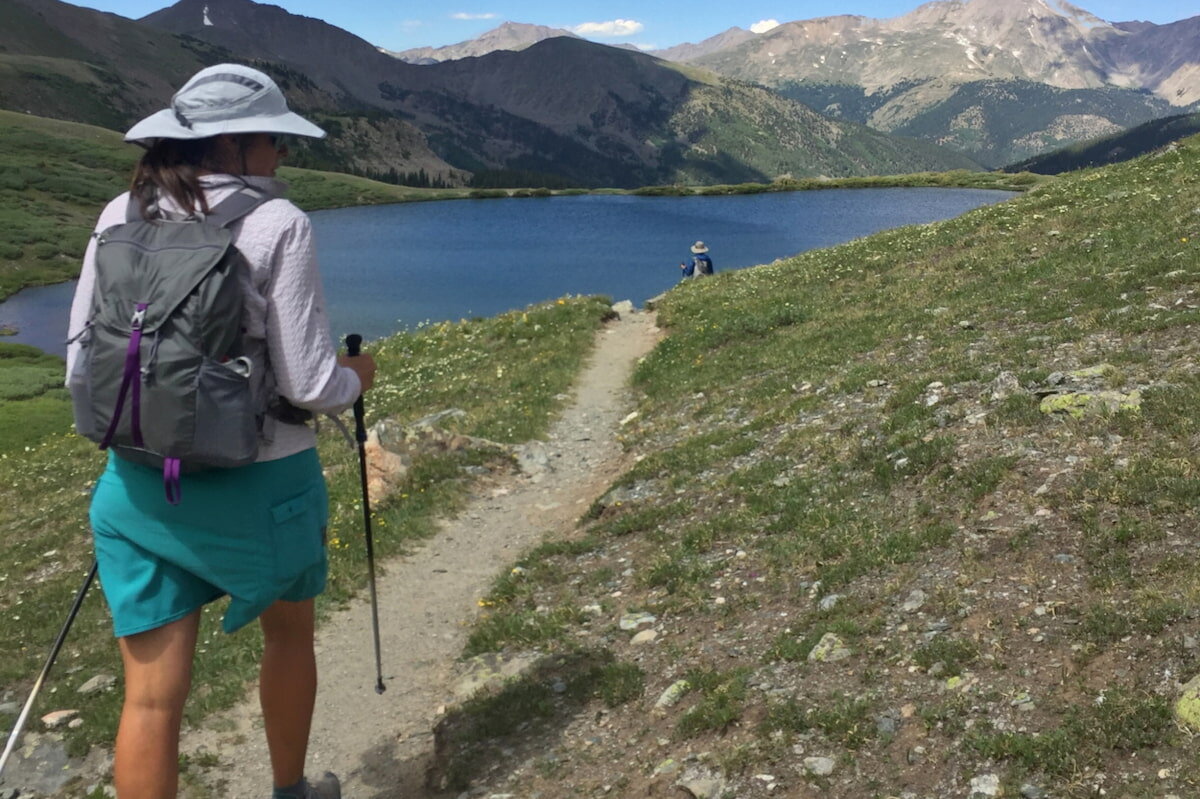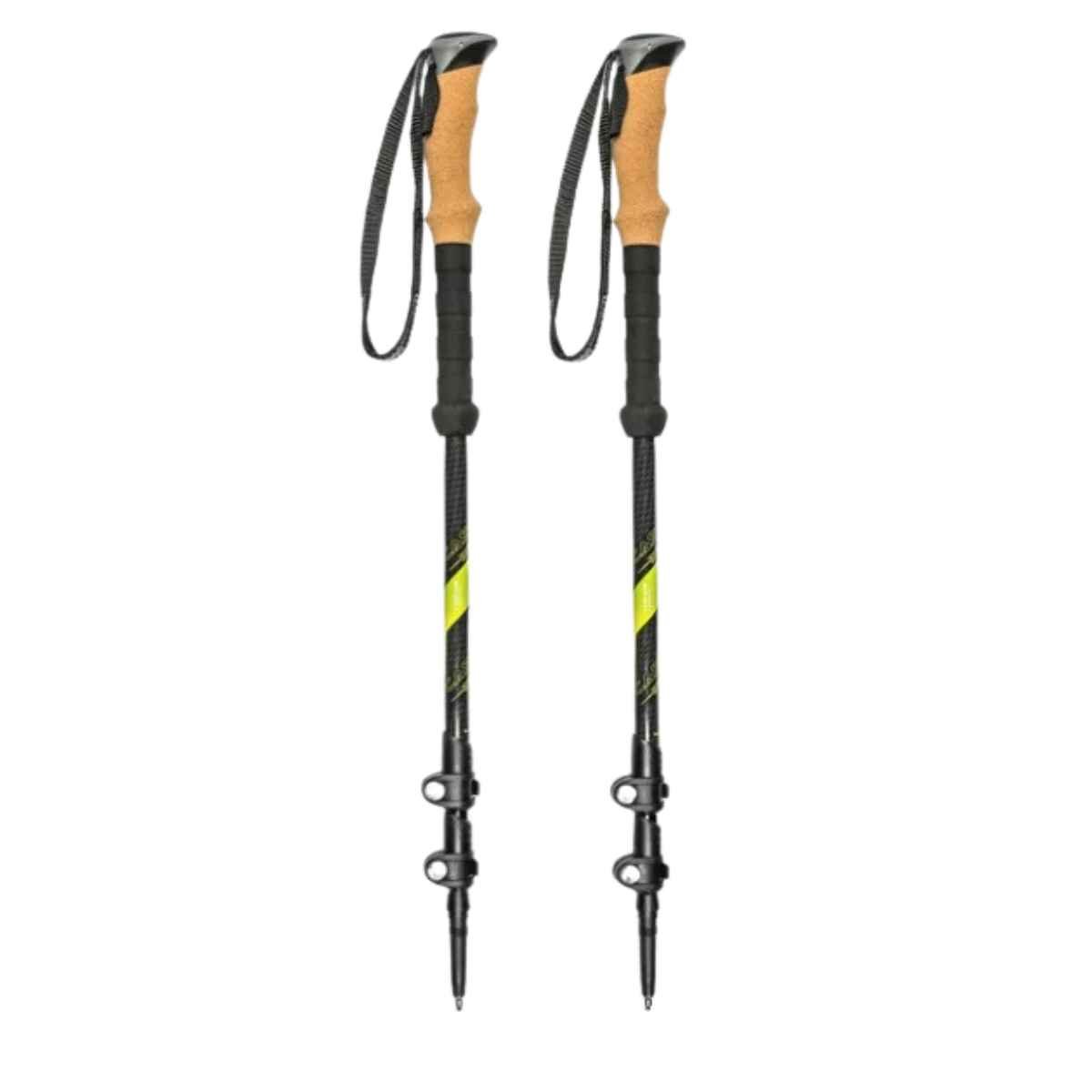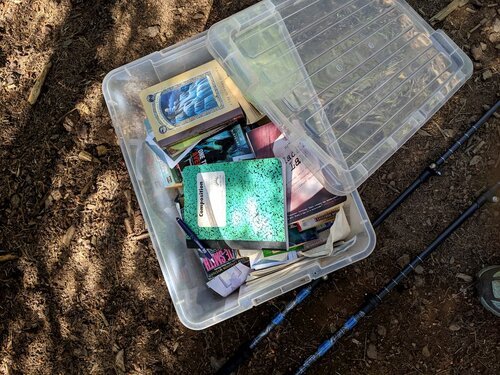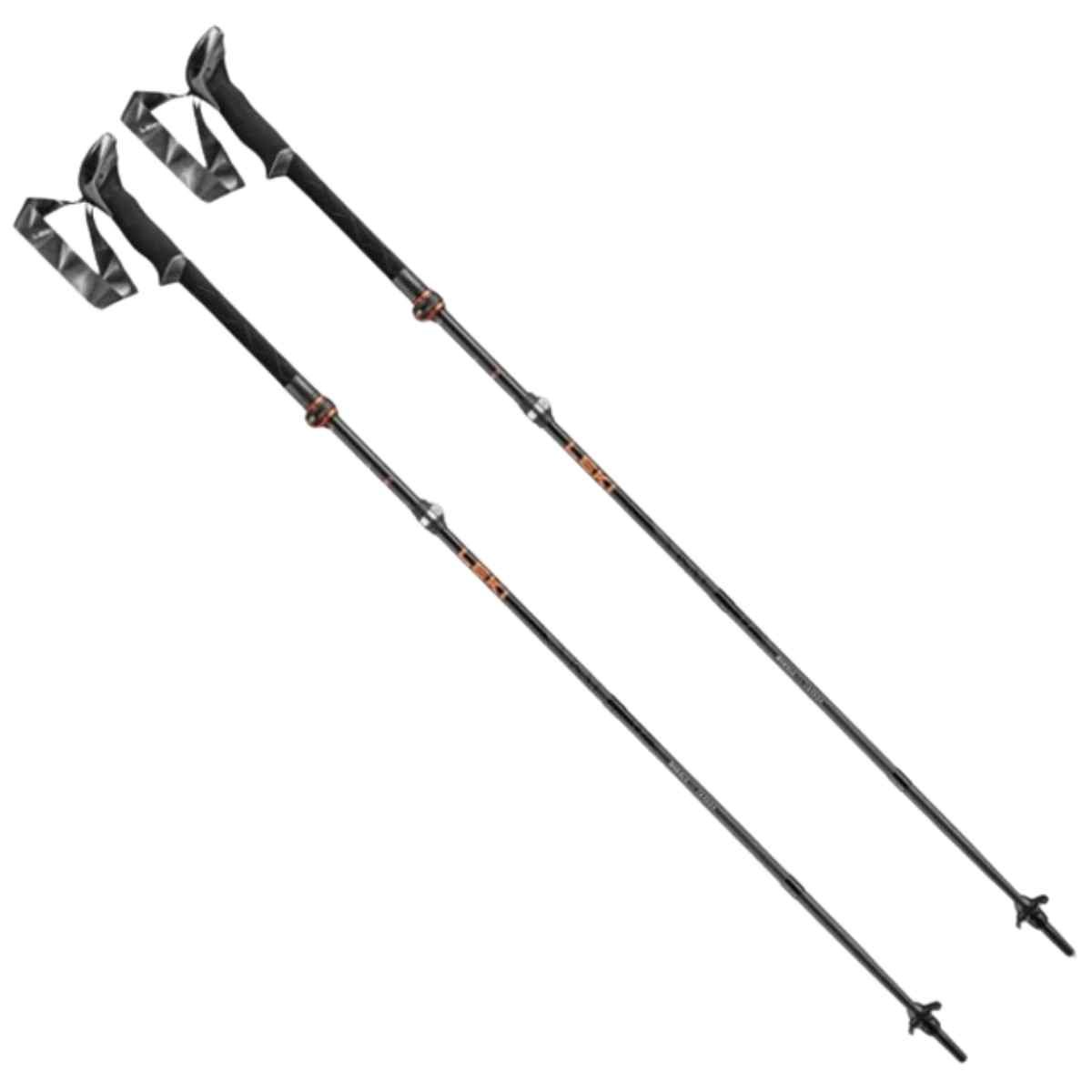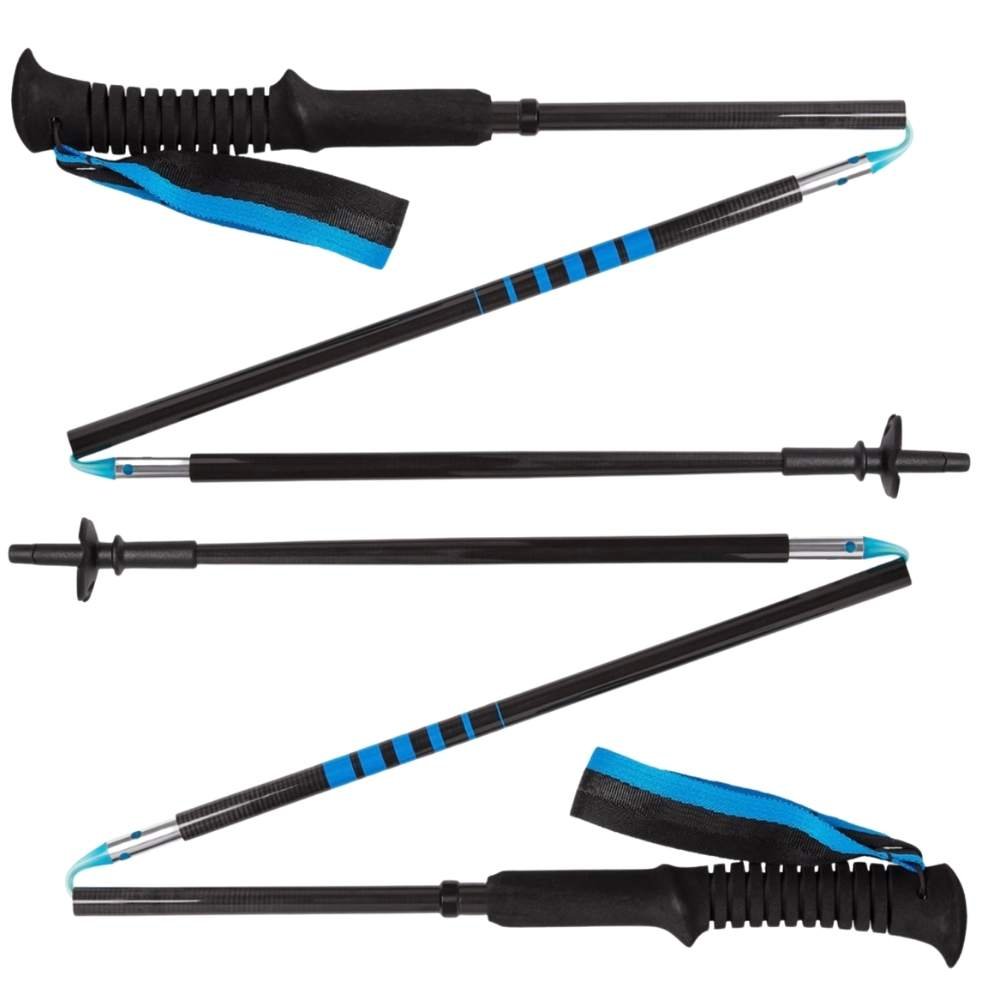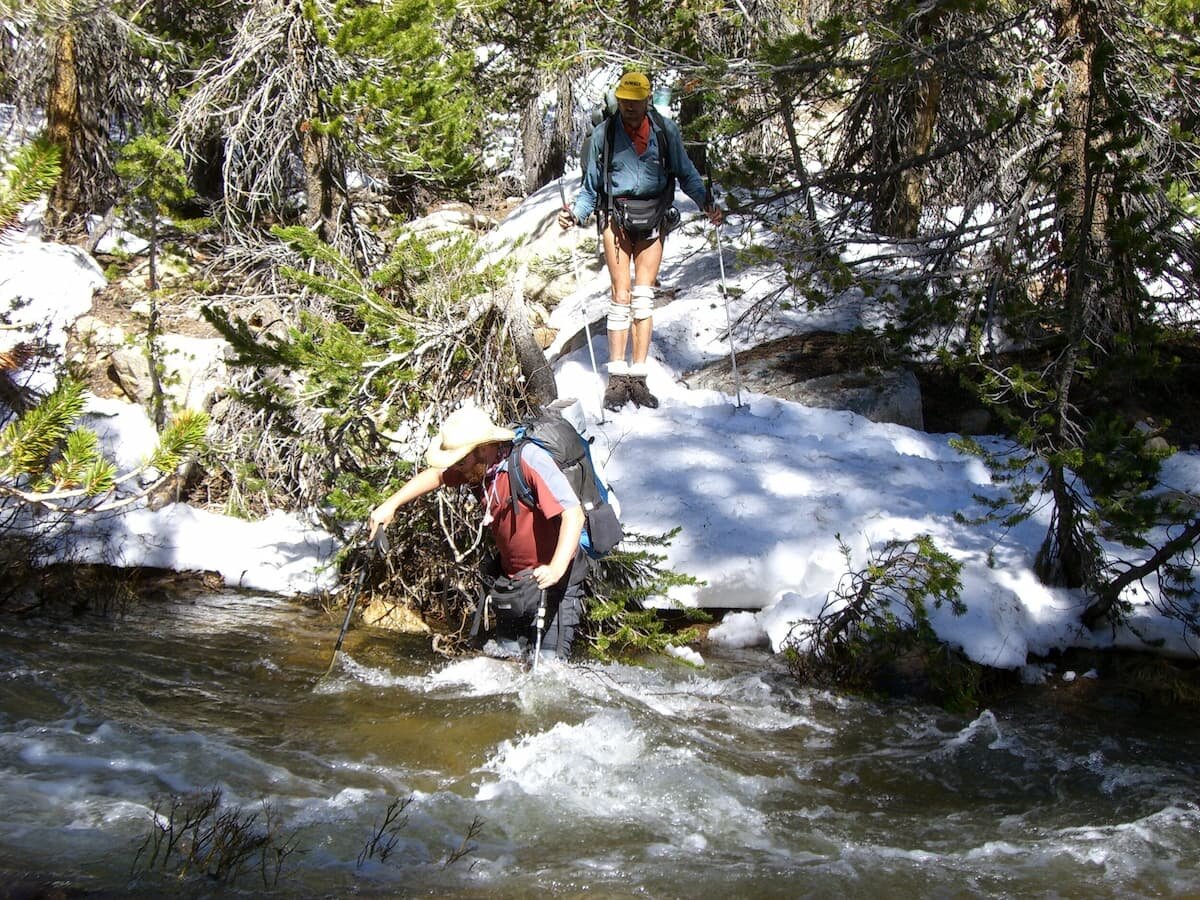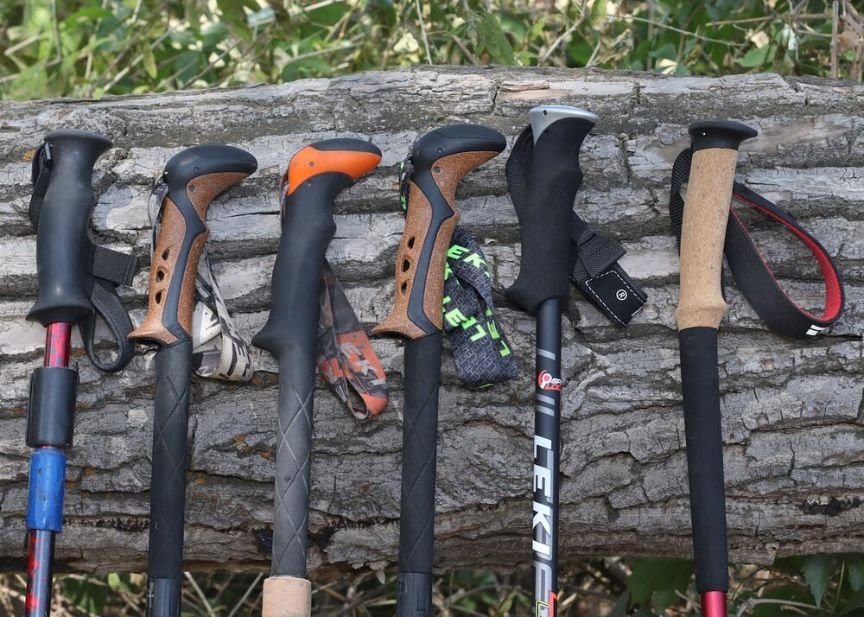Best Trekking Poles of 2024
The Top Hiking Poles for All Adventures and Abilities
March 24, 2024
Home > Gear Reviews > Hiking
Looking for trekking poles? Experienced hikers and backpackers have long appreciated the advantages of trekking poles.
While trekking poles may seem like optional gear, they’re actually one of the most multi-purpose gear items you can carry in the backcountry. Among our top reasons to use trekking poles:
They make river and stream crossings easier
They improve your balance
They protect your knees going downhill
We tested dozens of trekking poles over thousands of miles of hiking trails across the world. From ultralight to burly poles, here’s what we found.
We create reader-supported, objective, independently-selected gear reviews. This story may contain affiliate links, which help fund our website. When you click on the links to purchase gear, we may get a commission — without costing you an extra cent. Thank you for supporting our work and mission of outdoor coverage for every body! Learn more.
Comparison Table
| TREKKING POLES | TREELINE AWARD | PRICE | WEIGHT PER PAIR (ounces) | COLLAPSED LENGTH (CM) | MAX LEGNTH (CM) | SHAFT | GRIP | LOCKING MECHANISM | PACKING METHOD |
|---|---|---|---|---|---|---|---|---|---|
| Black Diamond Pursuit | Best Overall Read why |
$150 | 16.4 or 17.6 | 57.8 or 63 | 125 or 140 | Aluminum | Cork with EVA foam extension | FlickLock+ | Telescoping |
| Black Diamond Alpine Carbon Cork | Best Carbon Fiber Trekking Poles Read why |
$200 | 17.1 | 61 | 130 | Carbon Fiber | Cork | Lever Locks | Telescoping |
| Leki Legacy Lite | Most Durable Trekking Poles Read why |
$100 | 18.0 | 66 | 135 | Aluminum | Cork & rubber | Lever Lock | Telescoping |
| REI Flash Carbon Compact Trekking Poles | Best Lightweight Trekking Poles Read why |
$169 | 12.9 | 58 | 120 | Carbon Fiber | Foam | Lever Locks | Telescoping |
| Black Diamond Distance Carbon FLZ | Best Folding Trekking Poles Read why |
$210 | 11.6 or 12 | 34 or 40 | 110 or 125 | Carbon Fiber | EVA foam | Lever Locks | Folding |
The Best Trekking Poles
THE BEST TREKKING POLES: BLACK DIAMOND Pursuit
Shaft construction: 7000-series aluminum
Locking mechanism: External lever lock
Grip material: Cork with EVA foam extension
Adjustable wrist straps included: Yes
Weight per pair: 16.4 oz (S/M), 17.6 oz (M/L)
Maximum length: 125 cm (S/M), 140 cm (M/L)
Packing method: Telescoping collapsible shafts
What we liked: Built-in hex tool, durability, cork grip with foam extension, locking mechanism
What we didn't like: Collapsed length can be an issue (although the folding Pursuit FLZ are much more compact)
The Black Diamond Pursuit are our favorite poles because of their durability, comfortable cork grip with foam extension, reliable locking mechanism, and built-in tool for in-field maintenance. We've used these telescoping poles on hundreds of miles of well-maintained trails as well as rugged off-trail pursuits. They're tough and dependable, even on uneven terrain and with people who lean into their poles.
One of my long-standing complaints about trekking poles is that they are hard to adjust in the field – especially when you're out in the backcountry for an extended period, such as a thru hike. [In fact, in our review of the Black Diamond Trail Ergo poles, the predecessor to the Pursuits, one of our criticisms was that they were difficult to adjust in the field. It's almost as if Black Diamond read our review?]
Black Diamond has solved this with a built-in hex tool. The tool is in the top of the bottom section of one pole. You need to completely pull the pole out of the top section in order to use it. Tightening the locking mechanism is a cinch with the hex tool.
BLACK DIAMOND PURSUIT
The Black Diamond Pursuit poles are the successor to our previous favorite hiking poles – the Black Diamond Trail Ergo – and we're happy to report that the Pursuit are an improvement over the Trail Ergo in just about every way:
They're lighter
They collapse smaller
They come in two sizes
The locking mechanism is better
The ergonomic grip is more comfortable
The wrist straps are more comfortable
They have a built-in hex tool for in-field maintenance
GRIPS
In our tests, we found a stand-out feature of the Black Diamond Pursuit are the thoughtful grips. The cork material is comfortable and easy to hold—even when our hands were wet from rain or sweaty from the sun. Over time, the cork molded to our hands.
The Pursuits also come with foam grip extensions that wrap around from the handle to the shaft of the pole. The foam extensions are useful because in snowy conditions or on tricky or technical terrain, you may need to grip lower on the pole. In most of those situations, you would readjust the length of your pole. But the foam extension lets you do this without stopping to adjust. You can simply grip the foam lower on the pole.
Another advantage of the Pursuits is the ease of tailoring it to your adventures. They have compatible snow baskets that are easy to take on and off as conditions change on your hike. Snow baskets keep your poles from getting torqued, providing extra support for you in deep snow.
They also come with trekking baskets, which can help reduce noise, improve grip on rock, and reduce the impact on rocks.
LOCKING MECHANISM
Flick locks can be notoriously finicky, but we’ve found Black Diamond's "FlickLock+" soft-touch locking mechanism to be remarkably sturdy but easy to use. With other poles, if the locks are tight, sometimes you have to really press them to get them to lock. Not so with the FlickLock+. It was easy to shorten them when we preferred to carry our poles or for packing up. They also don't collapse when holding up all of your weight.
COMPACTNESS
Another criticism we had with the Pursuit's predecessor, the Trail Ergo, was the collapsed length. We thought the Trail Ergos were too long when collapsed. We're happy to report that Black Diamond delivered by reducing the collapsed size from 29" to 22.8" (S/M) or 24.8" (M/L). This is a HUGE difference. In fact, the only telescoping poles we tested that collapsed more were the REI Traverse.
If they’re still too long, we recommend checking out the Black Diamond Pursuit FLZ—the folding version.
TECHNICAL FEATURES
Using the built-in hex tool to adjust the locks of the Black Diamond Pursuit trekking poles. Photo courtesy Mike Unger.
The Pursuits come with a built-in hex tool to adjust the locks in the field. We're not sure if this is the first of its kind, but it's still pretty innovative. You simply remove the bottom section of the pole from the top, and the tool is at the top. Adjusting the locks with the tool is easy and simple. Anything that makes our lives easier while we backpack, without adding weight, is a huge win!
THE BOTTOM LINE
The Pursuit poles are for the frequent hiker who wants a versatile, long-lasting trekking pole. They're our choice for the best trekking poles because they provide the best balance of comfort, reliability, and features for most users.
THE BEST CARBON FIBER TREKKING POLES: BLACK DIAMOND ALPINE CARBON CORK
Grip material: Cork
Weight: 17.1 oz (pair); 16.8 oz (women’s)
Maximum length: 130 cm; 125 cm (women’s)
Shaft construction: Carbon fiber
Locking mechanism: External lever lock
Adjustable wrist straps included: Yes
Packing method: Telescoping collapsible shafts
What we liked: grip, durable, comfort, lightweight, quality easy-to-adjust flick locks
What we didn't like: not the lightest for carbon fiber, price
If you’re looking for a carbon fiber trekking pole that's durable, comfortable, and lightweight, we think the Black Diamond Alpine Carbon Cork are the best choice.
With a comfortable cork grip and metal flick lock lever locks, the Alpine Carbon Cork is the most reliable telescoping pole on the market. It takes the dependable features of the Black Diamond Pursuit, such as easy-to-adjust flick locks, and puts them into a carbon fiber pole.
One thing to note is that the Black Diamond Alpine Carbon Cork poles are heavy for carbon fiber: 17.1 ounces for the unisex pair compared to the 12.9-ounce REI Flash Carbon Compact poles.
As with other carbon fiber poles, be aware that this material can get brittle in the cold. Therefore, it isn’t our recommended pole for sub-freezing temperatures. We also wouldn’t recommend using a carbon fiber pole in the snow.
BLACK DIAMOND ALPINE CARBON CORK
UNISEX
WOMEN'S
Telescoping poles allow for versatility to adjust pole length from uphill, downhill, and flat sections. Photo by John Carr.
BLACK DIAMOND ALPINE CARBON CORK VS. REI FLASH CARBON COMPACT POLES
What makes us favor the Alpine Carbon Cork over the REI Flash Carbon Compact poles is the grip. First, we like the cork material on the Black Diamond better than the foam on the Flash. Cork better molds to the shape of your hands. Cork also absorbs sweat better and allows for a better grip. Second, the Alpine Carbon Cork has more secure grips than the Flash Carbon Compact.
From our own testing, we think the Alpine Carbon Cork can hold up better on off-trail adventures, especially in the snowy terrain.
For the absolute lightest carbon fiber trekking poles, a few of our staff exclusively use the Gossamer Gear LT5. However, fair warning: those poles need some care and aren’t recommended for people who crank on their poles. That’s why we think the Black Diamond Alpine Carbon Corks are the best option for everyone who wants carbon poles—even if you put a lot of pressure on your poles. They’re light but can take a surprising beating for carbon fiber.
We're not alone in praising the Alpine Cork. The Black Diamond Alpine Cork takes the #1 spot for happy customer reviews at REI and is also highly rated by the REI Co-op Journal. National Geographic Adventurer of the Year Andrew Skurka gave them high marks in Outside Magazine, logging in 450 days on rugged terrain including spring snow and off-trail canyons. Nearly every site we reviewed mentioned these poles. Most sites ranked these poles in their top three.
There are plenty of satisfied reviewers on Amazon. While they’re listed farther down on Amazon’s Best Seller list than we expected, they’re awarded the Amazon’s Choice rating (we suspect the lower ranking is because not every customer is looking for a carbon fiber pole).
THE MOST DURABLE TREKKING POLES: LEKI LEGACY LITE
Grip material: Cork and rubber
Weight: 18.2 oz (pair)
Maximum length: 135 cm
Shaft construction: Carbon fiber and aluminum
Locking mechanism: External lever lock
Adjustable wrist straps included: Yes
Packing method: telescoping collapsible shafts
What we liked: durability, price, warranty, quality flick locks
What we didn't like: weight
The Leki Legacy Lite are the poles we recommend for someone who always breaks their gear. They are the updated version of our favorite aluminum trekking poles, the Leki Legacy, which was a gold standard for many years. These poles are affordable, durable, and come with a lifetime warranty with time-tested proof they can withstand years and thousands of miles of abuse.
We purchased and relied on the Legacy on a 200-mile section of the Continental Divide Trail through the San Juan Mountain range in Colorado in 10 feet of snow. We found these poles to be heavy-duty, affordable, and surprisingly light for all they can handle.
LEKI LEGACY LITE
The Leki Legacy is a classic pole that has been serving hikers for years. Photo by John Carr.
The Leki Legacy Lite weighs just over 17 ounces each. While this update makes the Legacy about an ounce more than previous models, we think it's worth it for the durability, price, and ease of use. Although these are affordable poles, they still come with Leki’s signature “Speed Lock” system, which allows you to adjust each lock by hand.
The Leki Legacy Lite has optional snow and mud baskets, which allowed us to gain extra leverage while walking. Should the tips on the Legacy break or wear out, replacement tips are widely available.
Leki Legacy Lite Cor Tec poles (left) and Leki Legacy poles (right) on the Continental Divide Trail in the San Juan mountains. Photo courtesy Whitney LaRuffa.
On our San Juan Mountains traverse, we relied on the Leki Legacy Lite with the snow baskets. The strong aluminum shaft on the Legacy felt at times almost more like a ski pole-designed for the kind of torque and twisting associated with rugged terrain. The snow baskets allowed us to lift off of the snow more and get the most out of using poles in that kind of terrain.
One minor concern with the Leki Legacy Lite is that the top of the cork and rubber grip is flat rather than rounded, limiting the type of comfortable hand placements for these trekking poles.
THE BOTTOM LINE
Although it’s possible to find less expensive aluminum poles, one of the best reasons to choose any aluminum pole by Leki is that they are guaranteed for life (for shaft breakage only). We interviewed Junaid Dawud, part of the team who traversed all the Colorado 14ers (14,000-foot peaks) on foot as part of a thru-hike. He reported positive customer service at Leki (Dawud is not sponsored or an ambassador or employee of Leki). Leki’s customer service is well-recognized within the hiking community to work with you should any issues arise with your poles.
THE BEST LIGHTWEIGHT TREKKING POLES: REI FLASH CARBON COMPACT TREKKING POLES
Weight: 12.9 oz
Maximum length: 120 cm, folding poles also available
Shaft construction: Carbon and aluminum
Grip material: EVA foam
Locking mechanism: External lever lock
Adjustable wrist strap included: Yes
Packing method: telescoping collapsible shafts
What we liked: value for the price, weight, warranty, easy for travel
What we didn't like: grips, not good for cold temperatures
The REI Flash Carbon Trekking Poles are among the most highly rated hybrid carbon-aluminum poles available. REI’s #1 best-seller balances weight, price, durability, and ease of use. The newest version reduced the weight of a pair of poles down to 12.9 oz–among the lightest poles we tested. Paired with REI’s warranty and ease of returns, these are a great lightweight pole considered to be a solid pick among outdoors people.
The Carbon Fiber Compact makes travel easy. These collapse down to 23 inches-small enough for a carry-on size suitcase (but official TSA regulations say it’s still a no-go to for carry-on) . A previous model that had a push-button lock collapsed down to 18 inches, but with TSA rules requiring poles to be checked, one of the main attractions to having a more compact pole is no longer there.
REI FLASH CARBON COMPACT TREKKING POLES
The REI Carbon Flash are an affordable and reliable carbon fiber pole. Photo by Liz Thomas
Pro tip: We found these poles among the most adjustable of any we tested. To adjust the height, extend the bottom length fully and use the middle section to shorten and lengthen. If you’re concerned about measurement markings wearing off, use a Sharpie pen to mark your desired lengths or wrap duct tape around your poles at your desired height.
Another thing we liked about the Flash Carbons is the menu of options available. There’s traditional trekking pole and the compact version. There used to also be a women's trekking pole—which we used to recommend for most people who are 5’10” and under. Unfortunately, it appears to be discontinued. The women’s trekking pole weighed almost an ounce less.
As with other carbon fiber poles, be aware that this material can get brittle in the cold, so isn’t our recommended pole for sub-freezing temperatures. We also wouldn’t recommend using a carbon fiber pole in the snow.
Close up of the REI Carbon Flash poles. Photo by Liz Thomas
As with the other poles we recommend, we find that adding rubber tips to the REI Carbon Flash poles can give you a better grip when you’re hiking on rocky surfaces. Rubber tips also are less likely to leave scars on the rock and dirt.
Unfortunately, the latest iteration of the Flash appears to have a flaw with the grips where the top comes off. This hasn’t been an issue with our model, but it is possible REI has changed factories. The best part of the REI Co-op Flash is that they come with REI’s one-year return warranty, so you can easily return them if you find they aren’t right for you.
Related: The Best Hiking Shoes
The Best Ultralight Trekking Poles: Gossamer Gear LT5
Grip material: EVA foam
Weight: 9.8 oz (pair)
Maximum length: 130 cm
Shaft construction: Carbon fiber
Locking mechanism: Twist lock
Adjustable wrist strap: Yes
Packing method: Collapsible shaft
What we liked: Weight, can purchase just one pole
What we didn't like: Durability, price
By far the lightest trekking poles on the list are the Gossamer Gear LT5. While we originally dismissed these poles as a winner because they have such a specialized audience, we decided to add the LT5s back because they boast the highest customer reviews of any poles we looked at (5/5 stars with 200+ reviews-including from people who say they’ve broken these poles!). We’ve personally thru-hiked thousands of miles with these poles and these are our go-to poles for smoother trails.
While we don’t think these poles are for everyone, we’ve used the LT series for more than a decade. Popular with thru-hikers like ourselves, the 4.9 oz per pole LT5s are among the lightest trekking poles on the market. You can make them even lighted by opting to remove the wrist strap. The wrist strap has been updated to be placed in a more ergonomic position but is no longer removable. Cutting off the wrist strap saves 0.5 oz.
GOSSAMER GEAR LT5 TREKKING POLES
Liz Thomas in the Olympic National Forest with the Gossamer Gear trekking poles. Photo courtesy Liz Thomas.
Treeline editor Liz Thomas in Olympic National Park with the Gossamer Gear trekking poles.
THE LIGHTEST TREKKING POLE
What makes them the Ultralight Winner is that they are the sturdiest, most adjustable, and easiest to use of the ultralight poles available. We’ve logged thousands of miles with the LTs without an issue and enjoy handing them to other hikers and seeing the shock on their faces at how light these poles really are.
Fording with Gossamer Gear poles. Photo by Naomi Hudetz.
COMPACT
Trekking poles must balance weight, durability, and ease of use. In the most recent version of the Gossamer Gear LTs, a twist-lock mechanism gives it all the functionality of a heavier pole. It even telescopes down to 23.5” or 60 cm (shorter than our carbon winner, the Black Diamond Alpine Cork). While we prefer a flick lock to a twist lock, we understand that much of the weight savings from these poles come with that compromise. You’ll still have to check these poles according to TSA, but with poles that telescope down this small, it’s easy to stick them in your pack when you need hands for scrambling.
REPLACEMENT PARTS
As with earlier models, the replaceable rubber caps protect surfaces from scratching (and tips can be replaced as you use them). Gossamer Gear has the most customizable replacement part store we’ve seen, meaning you can fix your poles without having to wait on the phone or go back and forth on email with customer service. There are replacement tips, snow baskets, and pole sections (including the cork top section, should an animal take to munching on them).
Ultralight trekking poles come in useful in canyoneering situations where having poles is useful for walking through deep water but cliff-y sections may require carrying poles. Photo by Duncan Cheung.
A word of warning: if you know you are hard on your gear, are a heavier person, or are traveling on rough or rocky terrain, these poles may not be for you. These poles are truly ultralight and are much more susceptible to snapping than the other carbon fiber poles we considered. If you haven’t used trekking poles before, there’s a learning curve. With the LT5s, that learning curve could result in a broken pole (true story: I lent my LTs to my mom, who hadn’t used poles before, and she broke them within a few miles).
Like any pole, the LT5s are susceptible to getting caught between rocks. But unlike other poles, it’s much more likely to break as you try to pull it out (that’s one reason to always use the rubber tips to prevent getting stuck between rocks). Indeed, among the few customer's comments that mention broken poles, getting the pole tips stuck between rocks is a common reason for shaft breakage. A few customers reported breaking the shaft from tripping and falling on the pole. Still, amazingly, the review writers who say they broke their poles still gave it 5 stars, indicating that folks really enjoy using these poles, even if they know it won’t last forever.
The warranty will cover failure but requires you to follow user instructions to a T (which most people do not). However, you can purchase just the section that broke, minimizing the cost penalty. Compared to other poles we looked at, the replacement process is quite simple and doesn’t require calling customer service or sending emails, which is ideal for thru-hikers who can't sit around town waiting for an email from customer service to be returned.
Besides the compromise between weight and durability, another gripe about the LT5s is the price. However, the price is similar to other premium carbon fiber poles.
The advantage we see of going with the Gossamer Gear over those other carbon fiber trekking poles is that the LT5s are half the weight of the competition. If you are concerned about breaking your poles, go with a Leki pole because they come with a one-year warranty for shaft breakage. But if your primary concern is weight, you should opt for the Gossamer Gear instead.
Our editor Liz Thomas has taken these poles on thousands of miles including, the cross-country rocky Sierra High Route and the 1200-mile long Pacific Northwest Trail from Glacier National Park to Olympic National Park. “The only time I’ve snapped the pole in more than a decade of use was in transit,” she says. Like other users, even the ones who admit to having broken their poles, she’s fanatic about how much these poles can do with their minuscule weight.
Fording a knee-deep creek with the Gossamer Gear trekking poles on the Chinook Trail in Oregon. Photo by Whitney LaRuffa.
Lastly, the Gossamer Gear LT5s are a great option for folks who are traveling on terrain that requires a mix of scrambling and pole work, like the Appalachian Trail. Because they are so light and fold up nicely into a backpack, they are ideal for treks where you know you’ll have to carry your poles at least part of the time.
The LT5s are also the best option for folks who prefer to use poles only on river crossings or downhills to protect their knees, but otherwise don’t want or need the extra lift poles can provide on uphills.
The LT5s are lastly a great option for folks who use trekking poles to support an ultralight tarp or backpacking tent but otherwise aren’t big trekking pole users. While it’s possible to purchase ultralight poles to hold up tarps, their weight is similar to the LT5s and they aren’t multi-functional.
Looking to reduce weight even more? The Gossamer Gear LT5s are the only pole we considered where you have the option to buy only one pole. The trick is to leave a note that you’d only like “one pole” in the comment section of your order and they’ll refund you 50%.
Best Folding Trekking Poles: Black Diamond Distance Carbon FLZ Trekking Poles
Grip material: EVA foam
Weight per pair: 11.6 or 12.0 ounces
Maximum length: 110 or 125 cm
Shaft construction: Carbon fiber
Locking mechanism: FlickLock Pro
Adjustable wrist strap: Yes
Packing method: Foldable z-design
What we liked:
Easy to switch between rubber and carbide tips
Lightweight
Compact
What we didn’t like:
The tips are not durable
The foam grip is not as comfortable as a cork grip for extended daily use
The Black Diamond Distance Carbon FLZ are the best trekking poles if you want folding trekking poles that are very compact. They are excellent for day hikes and urban walking because they are more compact and lightweight than other poles due to the carbon fiber shaft. This makes them an excellent option for international travel, such as to Europe, where you may want to do a combination of city walking, sightseeing, and hiking that requires poles.
The Distance Carbon FLZ fold down into three parts with a collapsed length of 13 inches (small) or 15 inches (large)—the most compact of any pole we considered.
BLACK DIAMOND DISTANCE CARBON FLZ TREKKING POLES
We tested the poles on the Oregon Desert Trail. Here, we forded the Owyhee River with them.
Tester Mike Unger used the Black Diamond Distance FLZ for approximately 1,500 miles, including thru-hikes of the Oregon Desert Trail and Mogollon Rim Trail. Trekking poles have been an essential piece of gear for tester Mike Unger since he started long-distance hiking 16 years ago. He bought and tested the Black Diamond Distance FLZ because, while still aluminum, they were lighter and packed much smaller than the Pursuit.
The Distance FLZ comes with interchangeable tech tips. Rubber or carbide tips can be easily screwed into the base of the poles. This is great for folks who use rubber tips around town but want carbide tips for trail use.
These poles weren't designed for long-distance use. We recommend using a pair with more durable tips for thru-hiking. For example, the Black Diamond Pursuit (and most Leki trekking) use carbide flex tips. In testing, we consistently would get 1,500+ miles of use on the carbide flex tips before replacing the tips.
However, the Distance FLZ interchangeable tips needed to be replaced after only 750 miles. The screw-on tip system broke after about 1,000 miles. We were able to replace the screw-on tip with a Black Diamond Flex Tip to keep using the poles, but we still think the Pursuit or Leki tips are better for longer-distance adventures.
The Black Diamond FLZ on Steens Mountain in Oregon on a thru-hike of the Oregon Desert Trail.
COMPACT
The unique feature of the Distance Z and FLZ series is that the poles can be folded into three sections instead of collapsing into themselves like most trekking poles (like the Pursuit). This makes the Distance Z more compact when broken down. The Black Diamond Distance Z series comes in several models. The medium collapses down to 15", which is the most compact of any pole we considered.
The Black Diamond Distance Z is a fixed length and Distance FLZ are adjustable poles. Both the Distance Z and FLZ come in aluminum and carbon fiber models. The Black Diamond Distance Carbon Z has the same advantages of the Distance Z, but are more lightweight. The following are the specifications of each model:
THE BEST AFFORDABLE TREKKING POLES: CASCADE MOUNTAIN TECH CARBON FIBER QUICK LOCK
Shaft construction: Carbon fiber
Locking mechanism: External quick lock
Grip material: EVA foam or cork
Weight per pair: 15.6 oz
Maximum length: 137 cm
Adjustable wrist strap: Yes
Packing method: telescoping collapsible shaft
What we liked: price, durability
What we didn’t like: weight, locking mechanism
If you’re not sure if trekking poles are for you, the Cascade Mountain Tech Carbon Fiber Quick Lock is a cheap way to find out. The Cascade Mountain Tech is among the top five best-selling trekking poles on Amazon. They are also available at Costco and are a favorite of budget hiker Paul Magnanti, who covered them in his “Outfitted by Costco” story. We purchased and tested these trekking poles for 500 miles on the PCT and have continued to use them off-trail, on-trail, and everything in between. We've found the Cascade Tech poles to be intuitive to adjust and incredibly sturdy.
CASCADE MOUNTAIN TECH TREKKING POLES
Treeline Review editor Liz Thomas purchased and tested the Cascade Mountain Tech poles on a 500-mile section of the Pacific Crest Trail. Photo courtesy Liz Thomas.
The grips on the Cascade Mountain Tech are a hard-molded foam that could be more comfortable. Photo courtesy Liz Thomas
The Cascade Mountain Tech poles beat out the frequently recommended and similarly priced Montem Ultra Strong due to reports of better durability and relatively easy repair. At 15.6 ounces, they’re not particularly light for carbon fiber. But for the price, they can’t be beaten. While they come with either a cork handle or EVA foam grip, multiple sources mention durability as the reason to choose a foam grip from this manufacturer. To round them out, the tungsten carbide tips provide a nice grip on slick rock.
The Cascade Mountain Tech is mentioned often in guide Paul Magnanti’s budget gear lists, who believes it is possible to get quality hiking gear at Costco. It’s his go-to budget carbon fiber pick in his Sub-$300 Gear List guide. These Costco poles are also a budget pick of guide Andrew Skurka.
We purchased and tested a pair of the Cascade Mountain Tech for a 500-mile section hike of the Pacific Crest Trail. As we anticipated, we were initially surprised by the weight of the poles given that they are carbon fiber. However, we became accustomed to that weight over time and by the end of the 500 miles, didn’t notice it at all.
We found the Cascade Mountain Techs incredibly easy to adjust right out of the box and in the field. This was handy when using the poles to hold up a tent and needing to adjust the tent height in snowstorms. They’re incredibly durable and handled all sorts of abuse that we wouldn’t normally recommend, like throwing the poles in the back of a truck. We were quite impressed with how they performed, especially with the budget price tag.
The adjustable locks on the Cascade Mountain Tech (on the ground next to trail magic on the PCT). Photo by Liz Thomas.
These Cascade Mountain Techs poles are available with a cork handle or a foam handle. We tested the foam (it was all that the store had) but wished we had gone with a cork handle. The foam doesn’t mold as nicely to the hand as cork. It also doesn’t absorb sweat as well. We relied more heavily than usual on our wrist straps to avoid touching the grip. As with all poles we considered, we recommend using a cork grip.
The Cascade Mountain Techs seem to be universally beloved in the “Budget Trekking Pole” category. While it’s possible to get lighter poles or more durable poles, the Cascade Mountain Techs really are among the more impressive budget items we’ve tested for their ability to perform despite a budget price tag.
Read More: The Best Day Packs for Hiking
best poles for travel: Leki Makalu FX Carbon
Shaft construction: Carbon fiber
Locking mechanism: External lever lock
Grip material: Foam
Weight per pair: 17.8 oz
Maximum length: 130 cm
Collapsed length: 40 cm
Adjustable wrist strap: Yes
Packing method: Folding
What we liked: folds down the smallest of any poles we tested, warranty
What we didn’t like: Price
The Leki Makalu FX Carbon poles are our winner for best Travel poles. Collapsing down to an impressive 40 cm length (15”), they fold down the shortest of any poles we tested. That is an ideal length for bringing on a plane without a duffel bag or for trips where hiking is just one of many things you intend to do. That length is also ideal for multi-sport trips, such as those that require a bike or paddling. It’s also a nice length for backpacking trips or thru-hikes where you’ll be storing your poles away to use an ice axe or sun umbrella.
The Makalu FX Carbon is Leki’s replacement for the much-loved Micro Vario Carbon, our former Best Travel Poles winner. I’m rough on my gear and no stranger to trips, slips, and other kinds of torque on my poles, but I’ve never felt in danger of damaging either myself or these poles. I’ve used them to hold up my shelter, and they don’t slip or twist in the night.
LEKI MAKALU FX CARBON
I’ve tested the Leki Makalu FX Carbon on plenty of mountain trails and shorter overnight backcountry routes, and I can confidently say they’re a good balance of shedding some extra weight compare d tp aluminum poles without being delicate. These poles aren’t bent by an awkward fall or sideways pressure. These poles don’t feel like they are just for smaller or lighter-weight people. The Makalu FX Carbon are about an ounce heavier and an inch longer than the old Micro Varios when collapsed, but that’s a small price to pay for how sturdy these poles feel.
I like the extended foam grips, which I found myself using on steeper hills more often than I thought I would.
While I wish there was a smaller price to pay out of pocket, the Makalu FK Carbon poles have a similar price point to the old Micro Varios. But they come with Leki's warranty, which is among the best in the trekking pole industry. And if folded size, weight, and sturdiness are important to you, these Lekis will certainly go the distance.
Honorable Mentions
Black Diamond Distance Carbon Z
Shaft construction: Carbon fiber
Locking mechanism: Speed-cone
Grip material: EVA foam or cork handle
Weight per pair: 9.3 to 10.4 oz, depending on size
Maximum length: Fixed length. Sizes range from 110 to 130 cm
Adjustable wrist strap: Yes
Packing method: Folding
We also considered the Black Diamond Distance Carbon Z for the best carbon fiber trekking poles. However, we didn't find the interchangeable tips on the Distance Z as durable as on the Pursuit series. Additionally, the Distance Carbon Z is more expensive than the Alpine Carbon Cork. The big advantage of the Distance Carbon Z is that it folds down into three pieces and are more compact. Still, we think most users will prefer the durability of the Alpine Carbon Cork over the slight weight savings of the Distance Carbon Z.
BLACK DIAMOND DISTANCE CARBON Z
Additionally, within the Distance series, we liked the Black Diamond FLZ better. The Black Diamond Distance Z is a fixed-length trekking pole whereas the Distance FLZ that we recommend are adjustable poles. Both the Distance Z and FLZ come in aluminum and carbon fiber models. However, we recommend an adjustable-length trekking pole for most hikers.
You can adjust the height of the pole depending on whether you are doing uphill or downhill. You can also adjust the trekking pole height for different lightweight backpacking poles that require poles of different heights. See our section on adjustable vs. fixed length trekking poles for more details.
Three PCT hikers at Crater Lake National Park, all using trekking poles. Photo by John Carr.
DO I NEED TREKKING POLES?
Trekking poles can be essential when crossing rushing creeks and rivers. Here PCT hikers ford a snowmelt swollen creek during the high snow year of 2006. Photo by Mike Unger.
Trekking poles reduce knee strain, secure balance on uneven terrain or during creek crossings, and are essential to set up lightweight tents, filters, and camera systems.
The most common reason people choose to use poles is to protect their knees and reduce injuries. Michael Torry, director of biomechanics research at Steadman-Hawkins Sports Medicine Foundation in Colorado, found that trekking poles reduce the risk of injury in knees, calves, thighs, and hips.
Trekking poles also mean less impact on the body over time. Steadman’s research also shows that poles can reduce 4.4% of force. That may not seem like much, but it does add up over time.
We found 13 reasons for why to use trekking poles and list them out in Why use trekking poles. From setting up shelters to helping with river crossings to keeping our fingers from swelling, trekking poles help hikers and backpackers day-after-day.
The drawbacks of trekking poles can be the extra weight—especially if you must collapse them down because your hands are too cold to keep out of your pockets in the morning. Using trekking poles can make scrambling or using an ice axe more difficult. It may also be difficult to use a sun umbrella while using trekking poles. Trekking poles without rubber tips can also cause damage to rocks or have an environmental impact on the trail.
Six of almost a dozen models of trekking poles that we tested for this story. Photo by John Carr.
HOW TO CHOOSE TREKKING POLES
We describe in detail what hikers and backpackers should look for when choosing trekking poles in our How to choose trekking poles article.
Type of activity
Are you planning to scramble, rock climb, need an ice axe, or use a sun umbrella? Consider folding poles that can be easily put away and stored. If you’re sticking to trails, collapsible poles should be fine.
Pole material
Where are you going? If you’re headed to a place with snow or below-freezing temperatures, opt for aluminum. Carbon fiber can freeze and is more likely to shatter in cold. Aluminum is also more durable when exposed to twisting actions that are common while postholing in snow. If you plan to be exclusively on snow and even spend time on cross-country skis, we recommend using ski poles instead.
Grip material and shape
Are your hands sweaty? You may prefer the feel of cork grips, which are also great for hot weather. Foam grips are lighter.
Adjustability
Do you like to adjust the height of your poles depending on whether you’re hiking up or downhill? This can be a good practice to protect your knees and back. Some poles are easier to adjust than others. Some require tools like a screwdriver to adjust, which can be a pain in the field.
Weight
How much does weight matter to you? If you’re thru-hiking for long distances, you may want a lightweight pole. However, you can save some money by going for a heavier pole.
Wrist straps
Do you use wrist straps? If you don’t, consider learning how to properly use them. They can reduce strain on your hands and help you get more leverage while hiking, If the strap material isn’t comfortable, then you likely won’t use the strap. Test to see what you like. Do you have sensitive skin? Opt for a strap with soft fabric and padding.
Shock Absorption
Do you want shock absorption? Shock absorption is a system including a small spring, located in one of the joints or near the tip of the pole. This system purports to reduce impact and vibration on the downhill. But all our testers agree that they tend to make uphill travel harder, make poles weightier, cost more, and have more moving parts that can fail. In our opinion, they don’t do much.
Baskets and tips
Do you want your poles to come with all the accessories? Some poles come with snow baskets /mud baskets. When you’re hiking through snow and mud, your hiking stick simply sinks. A snow basket can help get more leverage and keep you afloat. Some poles come with rubber tips, which are helpful for urban hiking or Nordic walking, as well as reducing the environmental impact of poles. If you plan to be exclusively on snow and even spend time on cross-country skis, we recommend using ski poles instead, which come with dedicated snow baskets.
We tested and compared trekking poles side-by-side to determine which grips feel the most comfortable and mold to hands with movement. Photo by John Carr.
buying advice
After analyzing and aggregating reviews, we identified 17 sets of trekking poles that were praised by at least two reviewers. Using this criterion, we narrowed that list down to the top ten poles for most users.
Regardless of which brand you choose, your pole tips are going to wear out a lot faster than the rest of your poles. That’s why we advise choosing a poles where tips are easy to replace, as on the Black Diamond Pursuit. Photo by Mike Unger.
PRICE
We think the poles that will serve you best will be between $60 and $150.
POLE MATERIAL
We recommend aluminum, carbon fiber, and hybrid poles that attempt to capture the best features of both materials.
WEIGHT
Each pair of poles on Treeline Review is under 20 ounces, and half are even considered ultralight by REI.
REPLACEMENT PARTS
All of our winners have replaceable parts if something breaks.
Button lock adjustability on the Leki poles. Photo by John Carr.
ADJUSTABILITY
Most trekking poles are adjustable and able to increase or decrease in height.
SHOCK ABSORPTION
You may have noticed that none of our top winners include shock absorption. While two of our top winners can be purchased with shock absorption, we do not recommend shock absorbing poles.
TREKKING BASKETS
All of our winners come with optional interchangeable baskets for snow and mud.
We find lever lock mechanisms to be easier to use and more sturdy than twist locks. Photo by John Carr.
GRIP MATERIAL
We considered poles with grips made of cork and foam.
WOMEN’S TREKKING POLES
Some of our winners also come in a women’s version.
RUBBER TIPS
Rubber tips are a must if you plan on using your poles as walking poles for urban hiking or Nordic walking. They can also provide better grip in certain situations in the backcountry, and keep your poles from scarring the rocks.
LOCKING MECHANISM
On adjustable trekking poles, the locking mechanism keeps the pole at the length you set. All of our winners, except our ultralight pick, are equipped with lever locks.
If packability and portability are important to you either for travel or for hiking in areas where you may need your hands for scrambling or an ice axe, look for poles that fold. Photo by John Carr.
PACKABILITY
If you intend to travel with your trekking poles, you won’t want to keep them at their full length. While TSA Guidelines suggest you can’t fly with trekking poles in your carry-on, they can be checked in a suitcase or backpack.
Alternately, if you are hiking on terrain that will require you to your use hands or carry other equipment, such asn aice axe or umbrella, having folding or telecoping poles will be useful.
Trekking poles can help you on steep climbs like that on the Timberline Trail around Mt. Hood, Oregon. Photo by Kate Hoch.
FAQ
what is the difference between hiking poles and trekking poles?
Trekking poles are generally the same as hiking poles. Sometimes, you’ll hear people refer to hiking sticks or hiking staffs as hiking poles. But hiking sticks and hiking staffs generally are thicker, heavier, and designed to only be used as a single pole. Hiking poles and trekking poles are designed to be used with two poles.
CAN I USE SKI POLES AS TREKKING POLES? CAN I USE MY TREKKING POLES AS SKI POLES?
The answer to both of these questions is yes, theoretically. However, there are some drawbacks to both situations:
Ski poles are fixed length, while trekking poles are adjustable. If you like to adjust the length of your trekking poles for sustained uphill or downhill hiking, then using your ski poles isn’t ideal.
Making a turn while skiing puts a lot of stress on the poles. You’ll risk damaging your trekking poles, or worse, risk collapsing the poles when you need them most.
If you plan on using your pole as a tent pole, then a fixed-length ski pole will not work.
Two hikers using trekking poles to secure their footing on a snowy cliff in the Sierra on the Pacific Crest Trail. Photo by John Carr.
How to adjust and collapse trekking poles
It doesn’t matter how much experience you have in the outdoors. Sometimes, collapsing systems for poles just aren’t that intuitive. We learned this firsthand when one of our testers took out a new pair of poles. Our photographer has hiked thousands of miles with trekking poles and thought he could figure it out. But after some minutes of frustration, he called our editor from the top of a mountain on a Thursday morning to ask, “How do I collapse these things?”
Save yourself the trouble. Watch a YouTube video for your specific pair, especially if your poles have a button-release system. Your hiking self will thank you for it.
With a little practice, your new pole adjustment system will become second nature.
Always practice adjusting and collapsing your pole length before going into the field.
CAN I BRING TREKKING POLES ON A PLANE?
As of several years ago, TSA Guidelines state you can’t fly with trekking poles in your carry-on. However, they can be checked luggage. This means it is important to ensure that your poles collapse down to the size of your checked suitcase or duffel bag. All of the poles we recommend collapse by folding, telescoping, or disassembling into a z-shape.
If your poles don’t fit into your luggage, we recommend flying with a cardboard tube. However, with many airlines charging $25 or more on baggage fees, you may find that using USPS or UPS or FedEx to ship your poles could be more cost-effective than checking in your luggage.
Are there safety considerations when using trekking poles?
Generally, when properly used, trekking poles can relieve tension on your knees and other body parts to make hiking easier. They can also help with stability on uneven terrain. However, should a trekking pole fail and you had a lot of pressure on the pole, it may result in falling hard. This can cause severe injury, especially if you fall at a place with a deep drop. Be sure to get quality trekking poles you trust and always watch your step. No single piece is enough to stay safe on a trail.
Depending on your height, terrain, and the weight of your pack, you may need or want a longer or shorter pole. Photo by John Carr.
should i get Adjustable poles or fixed length poles?
We do not recommend fixed-length trekking poles if you plan to use poles with lightweight shelters. Different shelters have different recommended pole lengths to get a good pitch. With an adjustable pole, you can shorten the pole length to set up your shelter in "storm mode" in bad weather, or raise the height to get extra flow during warm nights.
TREKKING POLE maintenance and care
TIGHTEN YOUR LEVER LOCKS BEFORE YOU HEAD OUT FOR THE FIRST TIME
A common complaint in Amazon reviews of first-time trekking pole users was lock slippage, which is normal immediately after purchase. Open the lever and play with the tightness until you’re sure the pole will stay put. Some lever locks require a screwdriver to tighten, but others can be tightened with a dime, or with your fingers in some cases.
WHAT TO DO WHEN YOUR HIKING POLE TIPS BREAK
Tips take the brunt of the force when you’re hiking, so they can break or wear out faster than other parts of your poles. Don’t despair! Many poles allow you to replace the tips for about 1/5th the price of buying a new set of poles (see here for replacement Leki tips). Replace your tips at home, if you can. It’s most easily done with a crescent wrench and will take you about 5 minutes. And, as with most things these days, there is a YouTube video for replacing Leki tips.
TREKKING POLE MAINTENANCE TIPS
After each trip or at the end of the season, it’s good practice to:
Check for wear and tear
Replace broken tips and baskets
Clean your poles
Lubricate the joints
Adjust properly for your next trip
Store properly, free of moisture or mold or freezing temperatures
Treeline Review writer Katie Gerber tested the Micro Vario poles on the 800-mile long mostly off-trail Oregon Desert Trail. Photo by Whitney LaRuffa.
HOW WE tested
In researching trekking poles, we learned that while choosing the right poles may seem simple, minor differences in things like locking mechanisms can make or break a hike. No set of trekking poles is right for everyone, but knowing yourself, your trip, and your hiking style can go a long way to helping you find the trekking poles that are right for you.
For expert advice, we consulted Naomi Hudetz and Junaid Dawud, two long-distance backpackers who together have nearly 20,000 miles under their feet. In addition to being a Triple Crown hiker, Hudetz is also on the board of the American Long Distance Hiking Association - West. Dawud is a two-time Pacific Crest Trail thru-hiker and is best known for connecting all 58 of the Colorado fourteeners (14,000-foot peaks) on foot as a thru-hike. He’s previously worked for GoLite (RIP) and done hundreds of volunteer gear consultations, advising new thru-hikers on gear choices.
I personally have hiked over 3500 miles, including thru-hikes of the Pacific Crest Trail and Colorado Trail and a LASH (long-*ahem* section hike) of the Grand Enchantment Trail. Between those hikes and a stint as a Traveling Trainer for the Leave No Trace Center for Outdoor Ethics, I've slept outside for nearly a year of my life. Whether it's living on the road or living out of a backpack, traveling and just being in the outdoors is second nature to me.
Treeline writers Liz Thomas and Felicia Hermosillo hiking off-trail in the Sierra. Photo by Whitney LaRuffa.
To try to find the best trekking poles, we spent dozens of hours researching. Then we cross-referenced what we found with Amazon and REI customer reviews to determine the most important criteria for trekking pole users.
Then, we sent testers out on thru-hikes, backpacking trips, and day hikes on the Arizona Trail, Continental Divide Trail, Pacific Crest Trail, Oregon Coast Trail, John Muir Trail, and Corvallis to Sea Trail.
We also tested poles for ruggedness on off-trail routes like the Oregon Desert Trail and Blue Mountains Trail. Our testers swapped poles, took them from desert to alpine to snow.
We set up all sorts of backpacking tents with these poles. We crossed river fords like the Owyhee River on the Oregon Desert Trail and Evolution Creek on the John Muir Trail. We took them into the snow of the Steens mountains and San Juans in Colorado. We even bushwhacked with them through Joseph Canyon on the Blue Mountains Trail.
WHY YOU SHOULD TRUST US
Writer Amanda Jameson on the Pacific Crest Trail.
I personally have hiked over 3500 miles, including thru-hikes of the Pacific Crest Trail and Colorado Trail and a LASH (long-*ahem* section hike) of the Grand Enchantment Trail. Between those hikes and a stint as a Traveling Trainer for the Leave No Trace Center for Outdoor Ethics, I've slept outside for nearly a year of my life.
Whether it's living on the road or living out of a backpack, traveling and just being in the outdoors is second nature to me. I’m an American Hiking Society Next Generation Trail Leader and a board member at the American Long Distance Hiking Association-West, which awards the Triple Crown of Hiking. I run the popular blog Brown Girl on the National Scenic Trail, a space for intersectional writing to encourage folks of all colors and all walks of life to experience our wild spaces and preserve them for the future.
You can read all of Amanda’s stories on her author page.
SOURCES
Hiking Poles | Transportation Security Administration
In addition to our own product testing, we aggregated reviews from the following outdoor journals:
Christopher Knight and Graham Caldwell, Journal of Applied Sciences and Biodynamics
REI Co-op Journal and Trekking Poles and Hiking Staffs: How to Choose
We supplemented our research with interviews with:
Junaid Dawud, an explorer and adventurer part of the team who pioneered a thru-hiking route connecting on-foot all Colorado 14ers (14,000 foot peaks). Interview 6/3/18

